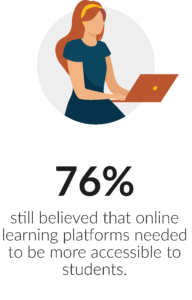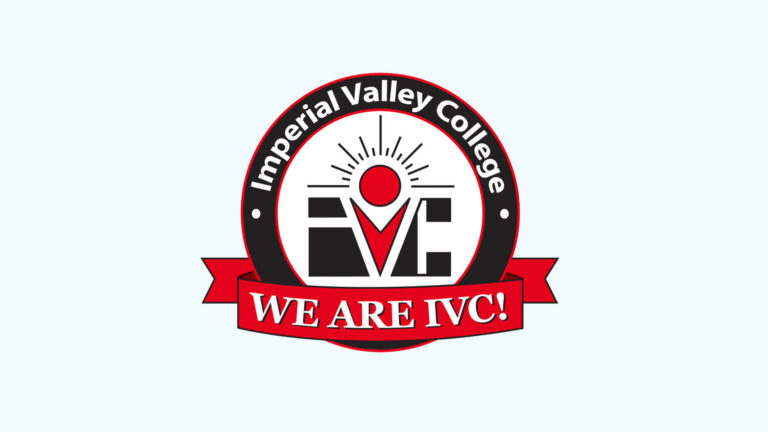Even before the global pandemic, a digital revolution was underway. However, COVID-19 has changed the education sector forever. From school, college, and university courses to language apps, video tutorials, and online training software, the entire industry has repositioned.
The spike in demand for remote learning courses throughout the COVID-19 pandemic led to exponential growth in the e-learning market. According to Business Wire, the value of the online learning industry is projected to pass $370 billion by 2026.
For savvy organizations, their potential market share in this booming market should be incentive enough to encourage maximum uptake of their courses. But when it comes to website accessibility, not everyone understands the scale of the impact that accessibility updates can make.
The Digital Evolution of Education in the COVID-19 Era

Lockdown restrictions and closures impacted the vast majority of brick-and-mortar learning institutions. UNESCO estimated that as of April 2020, over 1,500,000,000 students worldwide were unable to attend lessons.
The obvious answer was a transition to remote learning models. After all, remote learning is not a new concept. Institutions like Open University have been offering remote learning for decades. However, organizations not used to operating on remote learning models experienced significant growing pains and setbacks, including how to make their content accessible to students with a range of different access needs.
The principal challenge was providing equal access and the same level of inclusion online compared to in-person teaching. For example, according to Education Data Initiative, 43% of academic institutions offering higher-level education courses in 2020 invested in additional resources to aid remote instruction. Yet, 76% still believed that online learning platforms needed to be more accessible to students. This is still a vital consideration in today’s marketplace because statistics show that around half of all remote students plan to stick with online post-pandemic. That’s where accessible website technology comes in.
Why is an Accessible Website Important for Students?
For students with access to the appropriate technology and materials, evidence suggests that online learning is both more efficient and more effective than learning in a traditional setting:
- Students retain 25-60% more information online compared to in a classroom.
- Because students learn at their own pace, online course progression is 40-60% quicker.
- Online training is flexible and more convenient for students balancing work and family life with learning.

However, not every student learns in the same way, and online learning is not as straightforward as simply converting materials, lectures, and workshop plans into a digital structure. Different learning styles and different abilities must be accounted for. That means digital materials must accommodate people with varied access needs and be customizable to their unique style of learning.
What Accessibility Problems do Students Face?
Students at every level of education face accessibility barriers. Because access to education and skills training is vital to achieving economic growth and personal success, students need to be supported from early childhood through to tertiary and corporate training levels. Statistics show that in the US alone:
- 1 in 6 children between 3 and 17 have one or more developmental disabilities (CDC).
- Nearly 7 million disabled students are in schools across America (National Center for Education Statistics).
- About 5% of all students enrolled in higher-level education in the US are international students (International Student).
- 4.9 million children speak English as a second language (Education Week).
How to Make Your Online Learning Content More Accessible
The business benefits of being more inclusive are clear:
- The more students you attract and retain, the more profitable your organization becomes.
- By supporting a more diverse range of learners, you can attract the best students, develop a diverse and inclusive online campus, and enrich the learning environment for everyone.
- By welcoming and supporting international students, your organization stands to gain more in tuition fees and government funding.
But, exactly how do you create an inclusive online learning environment? The key lies in developing a platform that enables students to create personalized learning environments where they can:
- Access course materials and upload work.
- See their grades, gain feedback, and contact tutors.
- Keep a library archive of their coursework and projects.
- Watch online videos and lessons.
- Use messaging services and forums to easily communicate with tutors and other students.

Top Tips on How to Create an Inclusive Learning Environment
Organizations looking to provide the most inclusive online experiences should:
- Check-in with disabled students – Students with disabilities are likely to have additional requirements relating to online learning. Asking them about their needs and regularly reviewing how things are going is essential.
- Offer 1-1 support – Students with disabilities will have more questions and pain points than other students. Regular one-on-one virtual tutor appointments ensure everyone gets the support they need, and students don’t fall behind in their studies.
- Use accessible formats – Making your website and learning materials as accessible as possible by following best practices for font type, headings, color contrast, keyboard navigation, etc., will reduce student frustration and fatigue.
- Utilize ‘Live’ Learning – According to the Student Futures Commission, 66% of students want a blend of in-person and online teaching, and 45% want an in-person experience supplemented by online activities. Education providers can satisfy both criteria by incorporating face-to-face sessions in real-time.
How Recite Me Can Help
Our unique toolbar is an accessibility solution that allows students to customize a website in the way that works best for them, compensating for numerous access barriers, including:
- Visual impairments
- Deafblindness
- Color blindness
- Dyslexia
- Hyperlexia
- Dyspraxia
- Autism
- ADHD
- Speaking English as a second language
- Epilepsy
- Mobility and physical impairments
Comprising several accessibility features that can either be used individually or combined to make multiple adjustments for ultimate ease of use, users can:
- Personalize font size, type, and color options to make each web page easier to read.
- Utilize the mask screen tool, which isolates parts of the page to help with focus.
- Use the ruler tool to make reading easier.
- Download content as an audio file as an alternative to reading.
- Convert page content into over 100 different on-screen languages.
- Have the page read aloud in a choice of 65 different languages.
- Customize PDF documents and have them read aloud or translated.
Education Client Spotlight: Birkbeck University of London
Birkbeck University has been using Recite Me on its public-facing website since 2017. In 2020, the university improved its accessibility rating further by installing Recite Me on its internal Moodle platform. The results in just a few short months were astounding:
- The Recite Me accessibility toolbar was launched 81,279 times.
- 11,596 unique individuals used the Recite Me toolbar on the Moodle website.
- 220,448 individual styling features were utilized.
Interestingly for lecturers, our data shows that the most heavily used function was the screenreader, which demonstrates that students prefer having course content read aloud, just as they would in a classroom or lecture scenario.
“Adding the Recite Me toolbar has been a great success for our students. It is playing an important part in our goal to make all our digital tools and learning materials easily accessible to everyone.”
Brett Lucas, Head of Digital Education at Birkbeck University

What the Global Data Says
Recite me is now installed on over 4,000 websites, and over the last 12 months, our data shows that:
- The Recite Me assistive toolbar was launched over 4 million times
- Over 25 million web pages were viewed using the toolbar
- Over 5 million individual styling changes were made
- 31.5 million pieces of content were translated into different languages
- Over 43 million pieces of content were read aloud
The Future of Remote Learning
As the sector continues to expand and rely on online technologies more and more, experts predict continued growth across all levels and an increased focus on accessibility and inclusion as a strategy for optimizing for success.
“The interest in distance learning has been growing, but the real boom is still ahead. In the coming years, the education market will adapt to the needs of people born in the digital age, with an emphasis on technology.” John Unger (an author who specializes in education, business, and innovation)
School-Age Education – Having learned from the unforeseen upsets of COVID-19, schools worldwide are already developing cohesive plans to help students continue their studies during adverse situations, should the need ever arise again. In doing so, schools will have access to additional teaching tools that are more inclusive and better meet the needs of all students.
Tertiary Education – Having become aware of the common challenges students experience, competitive education providers will focus on removing barriers to effective distance learning by applying high-leverage practices (HLPs) that deliver more equitable access to high-quality remote instruction for an increasingly diverse range of students.
EdTech – More subscription-based models will emerge, offering personalized and convenient courses where students can curate their study plans, and education providers can scale their operations to meet demand. Current examples include:
- Masterclass
- Coursera
- Skillshare
- LinkedIn Learning
- Kahoot!
- Udemy
Corporate e-Learning – Businesses will focus on online rather than in-person methods to upskill their staff to boost efficiency and revenue. Current research already suggests that:
- Every $ invested in online training results in $30 in productivity.
- With e-Learning, participants learn nearly 5 x more material than in a classroom.
- Employees who learn remotely consume 90% less energy and produce 85% fewer carbon emissions.
Leisure Certifications – Not every qualification can be earned remotely. A certain degree of physical participation will inevitably be required for some activities. However, as consumer demand for flexibility and convenience grows, agencies providing certifications for leisure pursuits like scuba diving, rock climbing, and yoga will continue to develop e-Learning models where students can cover the theory online and complete the relevant in-person training at a later date.
Become Inclusive Today!
Recite Me can help you provide students with the skills, training, and knowledge they need to succeed. Our software is quick and easy to implement on your website and can usually be installed in under an hour.
For more information, please contact our team or request a live demonstration of our toolbar. To learn more about becoming accessible, give our online accessibility checker a try today.


